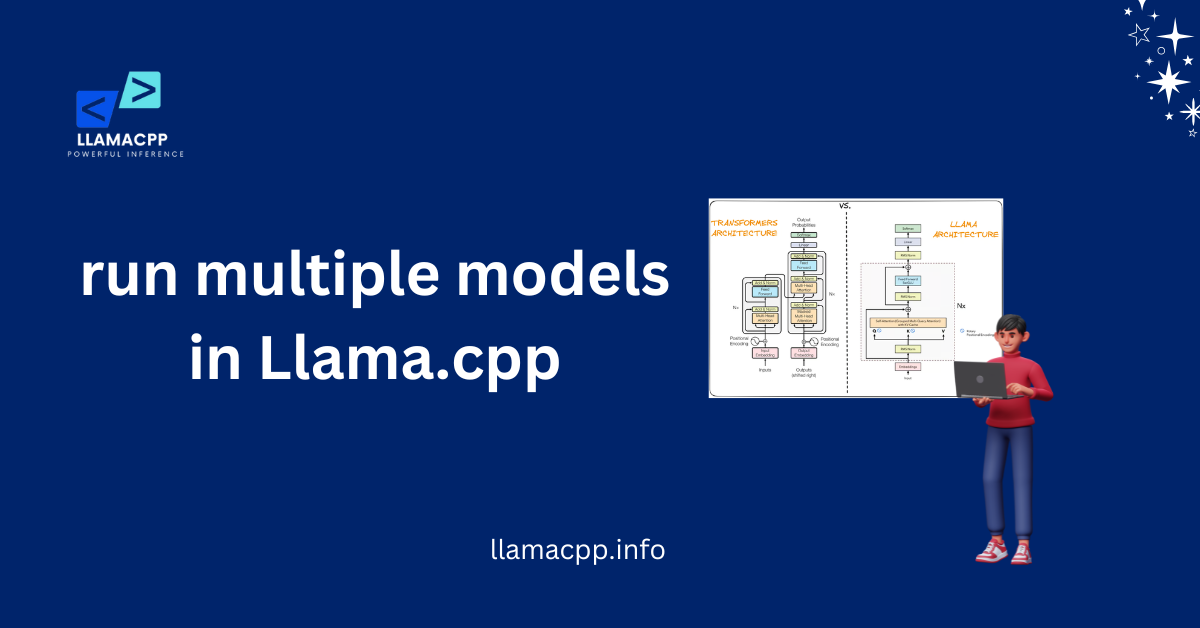Table of Contents
ToggleIntroduction
You’re in the right place if you want to load a model in Llama.cpp! You can work very well with AI models with Llama.cpp. It makes the process of loading, using, and engaging with these models easier and faster. It doesn’t matter if you’re new to AI or machine learning; it’s essential to know how to load a model correctly.
It will save you a lot of time to learn how to load a model in Llama.cpp. You can work with complicated models without a lot of trouble. This tool helps you get more done and keeps things running smoothly. To help you get the most out of Llama.cpp, we’ll show you step by step how to load a model.
How do I open Llama.cpp?
Llama.cpp is an easy to use, open source tool designed for working with machine learning models. It helps you load a model in Llama.cpp effortlessly, making your AI projects faster and simpler. For people who are new to AI or who have done it before, Llama.cpp makes loading models quick and easy.
This tool takes the hassle out of working with AI models. By using Llama.cpp, you can quickly load a model in Llama.cpp and get started right away. It’s built to save time and simplify the process, so you can focus on what matters most: your work.
Essential Things About Llama.cpp
- Llama.cpp is a tool for running and fine-tuning AI models efficiently.
- It supports both CPU and GPU for faster model inference.
- Helps in customizing models for specific datasets or tasks.
- Allows memory and performance optimization for large models.
Open-source and able to be changed
- Llama.cpp is open source, allowing anyone to view and modify its code.
- Users can adapt the tool to fit specific datasets, tasks, or hardware configurations.
- Provides flexibility to experiment with different model settings and optimization techniques.
Why Load Models in Llama.cpp?
- Loading models allows Llama.cpp to perform inference and generate predictions from your data.
- Ensures that the model is ready to process inputs efficiently, whether on CPU or GPU.
- Facilitates testing, fine tuning, and customization for specific tasks or datasets.
- Helps manage memory usage by loading only the required model size for your application.
- Enables quick switching between different models for experimentation or comparison.
Fast and Smooth Performance
Llama.cpp is very fast. When you load a model in Llama, cpp, it dashes without lag. This works excellent for chatbots and other AI powered tools that need to get things done quickly.
Works on Any Device
Llama.cpp is lightweight, meaning it can run on different devices without using too much memory. You can load a model in Llama.cpp, even on a basic computer or laptop, without issues.
Easy for Everyone
Whether you’re a coder or merely learning about AI, Llama.cpp keeps it simple. If you require loading a model in Llama.cpp, the tool is your friend with no hassle involved.

Prerequisites for Loading a Model
- Ensure that Llama.cpp is properly installed and compiled on your system.
- Verify that all dependencies like Python, CMake, and relevant libraries are installed.
- Install the latest GPU drivers (NVIDIA or AMD) and CUDA/ROCm toolkit if using GPU acceleration.
- Confirm that your system has sufficient RAM and VRAM to handle the model size.
- Download the model files from a trusted source and place them in the correct directory.
- Check that the model files are compatible with the version of Llama.cpp you are using.
- Preprocess any custom dataset if the model requires specific input formatting.
- Ensure proper permissions to read and write model files in the working directory.
- Set environment variables or paths if needed for CUDA, ROCm, or other dependencies.
- Verify storage space to accommodate the model and any temporary files generated during loading.
- Test with a small sample model to confirm that the system and Llama.cpp setup work correctly.
- Keep your system software and Llama.cpp repository updated to avoid compatibility issues.
Check the system needs.
Before trying to load a model in Llama.cpp, check your system’s memory and processing power. AI models need a good amount of RAM and CPU power to run smoothly. If your device is too slow, the model may not work correctly or could take too long to load.
Before you load a model, it’s a good idea to close any unnecessary programs and free up some space. This will enable multi-threading in Llama.cpp to run smoothly and avoid crashes or slow performance. Everything is ready, and you’re now able to load your model and begin working with AI.
Step-by-Step Loading of a Model
Suppose you’re ready to load a model in Llama.cpp, follow these simple steps. Doing it the right way ensures that the mol runs smoothly without errors. The step by step guide will make the lesson straightforward.
By following these steps, you’ll be able to load a model in Llama.cpp quickly. Whether you’re new to AI or have extensive experience, these instructions will help you set everything up right.
Step 1: open your terminal.
- Launch your system’s terminal or command prompt to interact with Llama.cpp.
- Navigate to the directory where Llama.cpp and your model files are located using the
cdcommand. - Ensure you have the necessary permissions to execute commands and access model files.
Step 2: Run the Model Loading Command
Now, type the command to load a model in Llama.cpp. Usually, this command looks something like:
./llama -m models/model_name.binReplace model_name.bin with the actual name of your model file. If everything is set up correctly, the model will start loading.
Step 3: Test the Model
After you load a model in Llama, cpp, it’s essential to test if it’s working. Try running a simple prompt and check if the model responds correctly.
How to Fix Common Problems
Sometimes, when you try to load a model in Llama, cpp, things don’t go as planned. The model might not load at all, give you errors, or run slowly. But don’t worry most issues have easy fixes.
When you know how to fix common problems, you can get back on track quickly. Let’s go over some frequent issues you may face when trying to load a model in Llama.cpp and how to resolve them.
The model Won’t Load
If your model doesn’t load, check the file path. The model file should be in the right directory and adequately named. If you see a “file not found” error, double-check the spelling and location.
Also, ensure that you’re using a compatible model format. Llama.cpp support CUDA and ROCm won’t be able to read the file if it’s not in the correct format, so you won’t be able to load a model correctly.
Performance is Slow
If the model is running too slowly, your system might not have enough memory or process you can shower. Large models require more RAM, so close other applications to free up resources.
Another tip is to use a smaller model if your device struggles to load a model in Llama.cpp. Reducing the model size can make it faster and better at what it does.
Unexpected Errors
Sometimes, mistakes happen due to computer reasons. Don’t worry restart your computer and try again. Restarting clears temporary issues and can help when you’re trying to load a model in Llama.cpp.
If the problem continues, check the Llama.cpp documentation or community forums for solutions. Many users share fixes for common issues, making it easier to find a solution.
Improving how Llama.cpp loads models
Optimization is very important if you want to load a model faster and better in Llama.cpp. A well-tuned setup ensures that the model runs without any lag or crashes. Small tweaks in the process can make a big difference in speed.
Using the proper techniques can reduce loading times and make things more responsive. Let’s explore some simple ways to enhance how you load a model in Llama.cpp for better speed and efficiency.
Use a less prominent model.
Suppose your system finds it difficult to load a model in Llama.cpp, you might want to use a smaller version. Performance can be slowed down because bigger models need more RAM and processing power.
A smaller model may work just as well for your needs while using fewer system resources. This makes it easier to run the model smoothly without crashes.
Enable GPU Acceleration
- Install the latest GPU drivers and CUDA (for NVIDIA) or ROCm (for AMD) to support Llama.cpp acceleration.
- Use the appropriate command line flags (
--gpu,--use-cublas, or--use-rocm) when running Llama.cpp. - Ensure your GPU has sufficient VRAM to handle the model and batch sizes.
- Monitor GPU usage to confirm that Llama.cpp is utilizing the GPU effectively.
Change the model’s parameters.
- Adjust hyperparameters such as learning rate, batch size, and context length for better performance.
- Modify precision settings (FP32, FP16, INT8) to balance speed and accuracy.
- Update layer configurations or LoRA settings to fine tune specific parts of the model.
- Test different parameter combinations to find the optimal setup for your dataset and hardware.
Conclusion
Learning how to load a model in Llama.cpp is an essential step in working with AI models efficiently. Whether you are a beginner or an advanced user, knowing the process helps you make the most out of Llama.cpp. Once you understand the right way to load models, you can use AI to do things like text generation, chatbots, and more without making mistakes or slowing down the process.
To be successful, you need to take the proper steps, fix common problems, and make sure performance is at its best. If you run into problems, simple fixes like checking the file path, adjusting model parameters, or enabling GPU acceleration can make a big difference. The more you practice, the easier it will become to load a model in Llama.cpp quickly and efficiently. You can discover endless possibilities and get the most out of AI-powered tools if you know what you’re doing.
FAQs
1. What is Llama.cpp, and why do we use it?
Llama.cpp is a lightweight and efficient tool for running AI models, particularly Meta’s LLaMA models. It’s made to work on a variety of devices, even ones with few resources, which makes it useful for AI tasks like text generation and chatbots.
2. How do I get a model to load in Llama.cpp?
To load a model in Llama.cpp, you need to first install it, then get a model that works with it, and finally use the correct command to load it. Making sure the model is in the right place and format is necessary for the loading process to go smoothly.
3. Why doesn’t Llama?cpp load my model?
If your model is not loading, check if the file path is correct, the model format is compatible, and your system has enough memory. Errors can also occur due to missing dependencies, so verify that all needed files are installed.
4. How can I make Llama.cpp load models faster?
You can speed up the process by enabling GPU acceleration, using Enablers like batch size and precision. Freeing up system resources by closing unnecessary applications.
5. What should I do if I get errors while trying to load a model in Llama.cpp?
If you find errors, restart your system and check for any missing dependencies. You can find solutions by reading error messages and looking at Llama. CPP’s documentation, or participating in community forums.



















